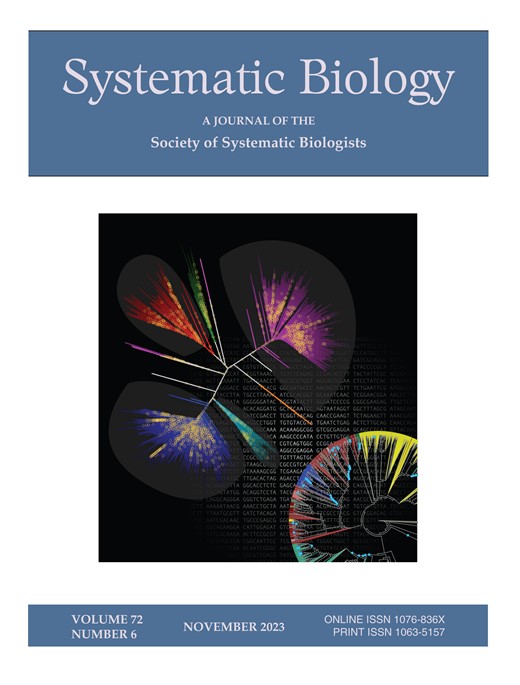Phylogenomics resolve the systematics and biogeography of the ant tribe Myrmicini and tribal relationships within the hyperdiverse ant subfamily Myrmicinae
IF 5.7
1区 生物学
Q1 EVOLUTIONARY BIOLOGY
引用次数: 0
Abstract
Ants are a globally distributed and highly diverse group of eusocial animals, playing key ecological roles in most of the world’s terrestrial ecosystems. Our understanding of the processes involved in the evolution of this diverse family is contingent upon our knowledge of the phylogeny of the ants. While relationships among most subfamilies have come into resolution recently, several of the tribal relationships within the hyperdiverse subfamily Myrmicinae persistently conflict between or within studies, mirroring the controversial relationships of the Leptanillinae and Martialinae to the remaining ant subfamilies. Another persistent issue of debate in ant phylogenetics is the timing of major evolutionary events as inferred via divergence dating. Here, we test the topology of the myrmicine tribes using genome scale data, inspect gene tree-species tree concordance, and use posterior predictive checks and tests of compositional heterogeneity to infer sequence characteristics which potentially introduce systematic bias in myrmicine tribal topology. Furthermore, we test the placement of the Baltic amber fossil †Manica andrannae by integrating phylogenomic and morphological data from nearly all species within the genus Manica, and a broad sampling of its sister genus Myrmica. Subsequently, we demonstrate the effect of fossil placement on overall divergence times in the Myrmicinae. We then re-evaluate the historical biogeography of the Myrmicini and Pogonomyrmecini considering newly generated genetic data and insights from our phylogenomic results. We find that our current understanding of tribal topology in the Myrmicinae is strongly supported, but this topology is highly sensitive to compositional heterogeneity and gene-tree species-tree conflict. Our fossil placement analyses strongly suggest that †Manica andrannae is a stem Manica species, and analysis of this fossil in context of the Myrmicinae demonstrates that a single fossil calibration point can have broad-scale cascading effects on divergence dates within the entire subfamily. The results of our biogeographic reconstructions indicate a South American origin for the Pogonomyrmecini + Myrmicini. Additionally, our results suggest that the MRCA of Myrmica may have inhabited the western Nearctic in the early Miocene prior to repeated dispersal across Beringia throughout the Miocene and Pliocene. The MRCA of Manica, on the other hand, was inferred to have a Holarctic range prior to vicariance during the Pliocene. Unexpectedly, we found strong support in the Pogonomyrmecini for three coordinated dispersal events from South to Central America during the early Miocene, which has been previously proposed as an early biotic interchange event prior to the more commonly accepted 3.5 Ma closure of the Isthmus of Panama.系统基因组学研究了蚁族金蚁族的系统学和生物地理学,以及超多样性金蚁亚科金蚁族之间的部落关系
蚂蚁是一种分布在全球的高度多样化的群居动物,在世界上大多数陆地生态系统中起着关键的生态作用。我们对这个不同家族的进化过程的理解取决于我们对蚂蚁系统发育的了解。虽然大多数亚科之间的关系最近得到了解决,但在超多样化亚科Myrmicinae内的几个部落关系在研究之间或内部持续冲突,反映了Leptanillinae和marialinae与其余蚂蚁亚科的争议关系。蚂蚁系统发育学中另一个持续争论的问题是通过分化年代法推断的主要进化事件的时间。在这里,我们使用基因组规模数据测试了桃金娘部落的拓扑结构,检查了基因树-物种树的一致性,并使用后验预测检查和成分异质性测试来推断序列特征,这些特征可能会在桃金娘部落拓扑结构中引入系统偏差。此外,我们通过整合几乎所有马尼卡属物种的系统基因组和形态学数据,以及它的姐妹属Myrmica的广泛样本,来测试波罗的海琥珀化石†Manica andrannae的位置。随后,我们证明了化石放置对金雀科总体分化时间的影响。然后,我们重新评估了Myrmicini和Pogonomyrmecini的历史生物地理学,考虑了新产生的遗传数据和系统基因组学结果的见解。我们发现我们目前对桃金娘科部落拓扑结构的理解得到了强有力的支持,但这种拓扑结构对成分异质性和基因树种树冲突高度敏感。我们的化石定位分析强烈表明†Manica andrannae是一个干Manica物种,并且在Myrmicinae背景下对该化石的分析表明,单个化石校准点可以对整个亚科的分化日期产生广泛的级联效应。我们的生物地理重建结果表明,Pogonomyrmecini + Myrmicini起源于南美洲。此外,我们的研究结果表明,Myrmica的MRCA可能在中新世早期居住在新北极西部,然后在中新世和上新世期间反复扩散到白令陆桥。另一方面,推断马尼卡的MRCA在上新世之前具有全北极范围。出乎意料的是,我们在Pogonomyrmecini中发现了中新世早期从南美洲到中美洲的三次协调扩散事件的强有力支持,这一事件之前被认为是巴拿马地峡3.5 Ma关闭之前的早期生物交换事件。
本文章由计算机程序翻译,如有差异,请以英文原文为准。
求助全文
约1分钟内获得全文
求助全文
来源期刊

Systematic Biology
生物-进化生物学
CiteScore
13.00
自引率
7.70%
发文量
70
审稿时长
6-12 weeks
期刊介绍:
Systematic Biology is the bimonthly journal of the Society of Systematic Biologists. Papers for the journal are original contributions to the theory, principles, and methods of systematics as well as phylogeny, evolution, morphology, biogeography, paleontology, genetics, and the classification of all living things. A Points of View section offers a forum for discussion, while book reviews and announcements of general interest are also featured.
 求助内容:
求助内容: 应助结果提醒方式:
应助结果提醒方式:


